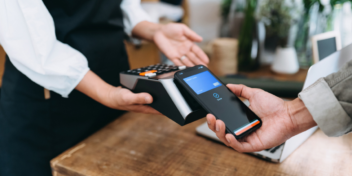If you’re like most people, plastic is your preferred form of payment. Whether you use a credit card or debit card, swiping or tapping your card at the register is a lot simpler than dealing with cash or checks.
Contactless cards have skyrocketed in popularity. According to the Federal Reserve, contactless card payments increased 172% between 2019 and 2020, with over 3.7 billion transactions completed.
With that increased popularity comes a higher risk of fraud. To address that issue, card issuers use chip technology to prevent theft. But how do debit card chips work?
What Is the Purpose of Debit Card Chips?
Debit cards eliminate the need to carry bills or coins. You can just use your card to complete transactions online or at the register at your favorite store. When you pay with a debit card, the money is automatically withdrawn from your checking account — without the need for cash or paper checks.
However, debit cards come with some risks. Some criminals attempt to hack payment processors or use card skimming devices to steal debit card information. With stolen debit card details, they can take money directly from those individuals’ bank accounts.
It’s a major problem. According to the Federal Trade Commission’s Sentinel Data Book, in 2020, there were over 63,000 debit card fraud reports, totaling over $117 million in lost dollars. In fact, incidences of bank fraud — including debit card, ACH, and electronic funds transfers — increased by 32% from the previous year.
To try and fix the problem, debit card issuers instituted chip card technology. On physical debit cards, the cards have a small silver chip on the front. The purpose of debit card chips is to protect your payment data, and they are a useful tool in combating fraud.
How Do Debit Card Chips Work?
Chips in debit and credit cards provide additional protection and security. When you make an in-person purchase with your debit card, the chip on the card encrypts your payment information.
The chip provides a unique code that is required for the transaction to be approved. The code is only usable for that one transaction; after that, it expires and cannot be used again. Because the codes are only valid for one use, chips in debit and credit cards make it much harder for criminals to steal your card information.
The encrypted data is sent to the retailer’s payment processor, where it’s verified and approved. If there are any issues with the payment, the chip will reject it.
Chip cards are also harder to counterfeit than traditional magnetic stripe cards. To create a fake chip card, criminals would need to steal or duplicate your physical card as well as hack into the encryption software. That process is much more difficult than copying your debit card number onto a new piece of plastic.
Learn More: What is Tokenization? An Intro to Digital Wallets
What Should I Do If My Card’s Chip is Damaged?
While the purpose of debit card chips is to increase your security, they can be damaged and stop working. If that happens, you won’t be able to use contactless payments anymore, but your card will still work if you swipe it rather than insert it in the terminal. You will likely need to enter your PIN, but otherwise, the transaction will be processed as a normal debit card purchase.
However, you shouldn’t keep a damaged debit card for long; the more you use a card with a damaged chip, the more likely you are to become a victim of debit card fraud.
If your card’s chip is scratched or otherwise impaired, follow these steps:
- Clean It: This may sound silly, but many times, the card is just dirty rather than flawed. If you rub the card with a warm, damp cloth, you might find that the chip looks brand new and can be used for contactless payments again.
- Contact Your Bank: You can call your bank’s customer service number — usually listed on the back of your debit card — or visit a branch in person. If you show them your damaged card, they will issue you a replacement. If you go in person, you could receive a new card immediately, but if a card needs to be mailed, it can take a few days.
- Protect Your Card: Once you receive your new card, take extra steps to protect it to prevent it from getting scratched or ruined. Don’t store your cards loose in your purse or bag; keep them tucked into their own compartments in a wallet, or use a RFID-blocking card holder for added protection.
Looking for a new bank? With SouthEast Bank, you can open a new checking account at any of its branches and have a debit card printed right away.
All of SouthEast Bank’s debit cards come equipped with 24/7 fraud monitoring through SouthEast Verifi, so your debit card is always monitored. If your card is used in a transaction that shares characteristics typical of unauthorized transactions, SouthEast Bank will decline it and contact you by phone or text.
Visit a SouthEast Bank branch today to open your account and get your new debit card.
Information contained in this blog is for educational and informational purposes only. Nothing contained in this blog should be construed as financial, legal or tax advice. An attorney, financial advisor, and/or tax advisor should be consulted for advice based on your circumstances.
Links to other websites or references to services or applications are provided as a convenience only. A link does not imply SouthEast Bank’s sponsorship or approval of any other site, service or application. SouthEast Bank does not control the content of these sites, services or applications.




